-
Welcome back Guest! Did you know you can mentor other members here at H-M? If not, please check out our Relaunch of Hobby Machinist Mentoring Program!
You are using an out of date browser. It may not display this or other websites correctly.
You should upgrade or use an alternative browser.
You should upgrade or use an alternative browser.
Just brought home a South Bend 9A...
- Thread starter thenrie
- Start date
- Joined
- Apr 23, 2011
- Messages
- 2,476
Nice score and nice job on the clean up.
Tony, is that just a mis spell? Or did that come with the lathe also?
Cheers Phil
.... I also disassembled, cleaned, de-rusted, lubed, and reassembled the 2-jaw today. Feels nice and smooth now......
Tony, is that just a mis spell? Or did that come with the lathe also?
Cheers Phil
- Joined
- Oct 7, 2013
- Messages
- 305
I haven't read that particular book, but others, including the South Bend book, say you can align the lathe by turning a test piece and measuring near the chuck and near the tailstock center. You're actually supposed to turn it between two centers, but I just dialed-in my 4-jaw with a tool in the holder and did it that way. The long and short is that if the lathe is turning both ends the same diameter, it's good. My test piece wasn't as long as recommended, and I didn't worry about polishing it or getting a perfect finish, but it's good enough for what I'm doing right now.
Maybe somebody who has a little more experience could chime in here and give us a little coaching.
Maybe somebody who has a little more experience could chime in here and give us a little coaching.
- Joined
- Oct 7, 2013
- Messages
- 305
I've been making some nice chips with my SB9. So far, in making parts for my Delta Rockwell 11 lathe, I've learned to do the following:
- basic turning
- tool bit grinding
- parting off
- chamfering
- making and using mandrels
- screw threading
- Lathe setup and adjustment
- cleaning and maintaining the SB lathe
Monday I'll learn how to use a boring bar to resize a bushing to fit a freshly ground journal in the DR 11 spindle.
Here's a pic of some of the shafts I've made to replace worn parts in the DR.
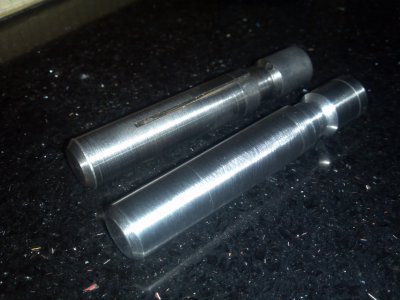
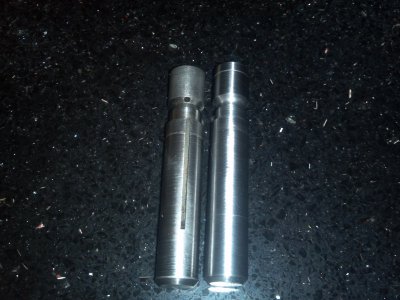
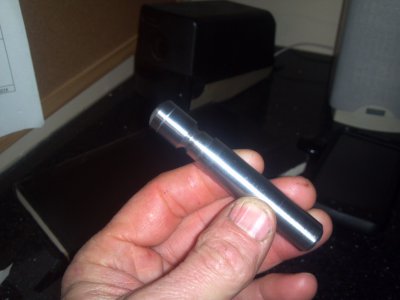
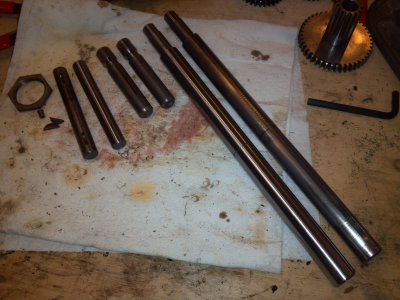
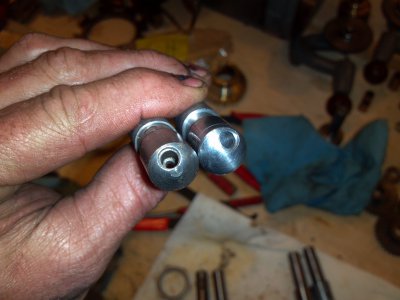
Here's a pic of me turning the last .002 off the OD of a bushing to resize it for a press fit into the pulley gear for the DR. The SB is working like a charm.
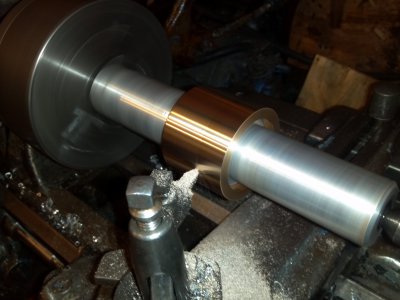
I also got to use the Palmgren milling attachment to drill an angled oil hole in a shaft (photo above of the shaft). I forgot to get a picture of the process. I also need to post a picture of my first effort at cutting threads. I cut threads on the end of a shaft that fits into a cylindrical nut. Amazingly, it came out perfect.
I'm having fun!






- basic turning
- tool bit grinding
- parting off
- chamfering
- making and using mandrels
- screw threading
- Lathe setup and adjustment
- cleaning and maintaining the SB lathe
Monday I'll learn how to use a boring bar to resize a bushing to fit a freshly ground journal in the DR 11 spindle.
Here's a pic of some of the shafts I've made to replace worn parts in the DR.





Here's a pic of me turning the last .002 off the OD of a bushing to resize it for a press fit into the pulley gear for the DR. The SB is working like a charm.

I also got to use the Palmgren milling attachment to drill an angled oil hole in a shaft (photo above of the shaft). I forgot to get a picture of the process. I also need to post a picture of my first effort at cutting threads. I cut threads on the end of a shaft that fits into a cylindrical nut. Amazingly, it came out perfect.
I'm having fun!






- Joined
- Oct 7, 2013
- Messages
- 305
Thanks ARM. I'm just learning. Getting lucky, I guess.
Here's a shot of me learning how to use the boring bar. That's the bushing for the pulley gear from the headstock of my Delta Rockwell 11 being turned on my South Bend 9A. You see the pulley gear chucked up in my 4-jaw, dialed to less than .0005 runout on both ends, froze the bushing and slid it into place, then turned the inside diameter to within .016 of the outside diameter of the fresh spindle journal it will run on. Now I'll take the pulley gear and spindle to a local machine shop to have the bushings reamed to the finished size. The reason I had to do it this way is because I had to have the spindle journal turned down about .020, due to wear from poor lubrication. I bought bushings that were 2.250 on the ID and turned them to 1.986. The new journal is 2.002.
Making parts for the Delta Rockwell on the South Bend has been a great learning experience. I've had to do a wide variety of first-time operations. So far, nothing has turned to scrap (knock on wood).
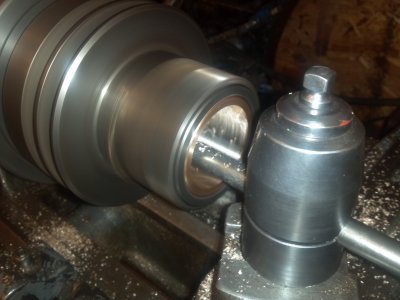

Here's a shot of me learning how to use the boring bar. That's the bushing for the pulley gear from the headstock of my Delta Rockwell 11 being turned on my South Bend 9A. You see the pulley gear chucked up in my 4-jaw, dialed to less than .0005 runout on both ends, froze the bushing and slid it into place, then turned the inside diameter to within .016 of the outside diameter of the fresh spindle journal it will run on. Now I'll take the pulley gear and spindle to a local machine shop to have the bushings reamed to the finished size. The reason I had to do it this way is because I had to have the spindle journal turned down about .020, due to wear from poor lubrication. I bought bushings that were 2.250 on the ID and turned them to 1.986. The new journal is 2.002.
Making parts for the Delta Rockwell on the South Bend has been a great learning experience. I've had to do a wide variety of first-time operations. So far, nothing has turned to scrap (knock on wood).


- Joined
- Oct 7, 2013
- Messages
- 305
The fact that it has U.S. stamped on it leads me to believe it was a govt machine. I don't think that was normally a part of the SB serial number. The person who owned the machine before me was beyond reproach, and he owned it for a long time, possibly even got it from his father, so I doubt seriously it was a stolen machine at any time. I can't figure why the govt would have tried to obliterate the serial number, though, unless they just wanted the machine destroyed. For a while there after WW2, the govt, or at least certain agencies, didn't have an easy way to convert govt property to private use when it was surplussed, so it was simply destroyed and recycled for the metal. I'm thinking this unit was "destroyed" by some enterprising person who saved it from the smelter.
Regardless of its provenance, I'm please with the way it's cutting.
Regardless of its provenance, I'm please with the way it's cutting.
